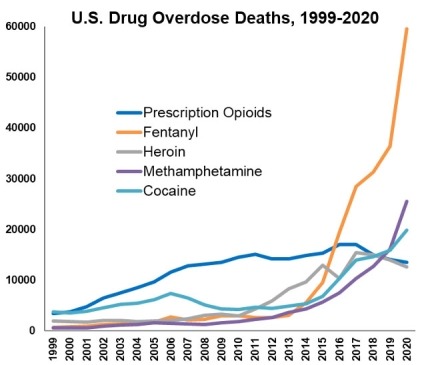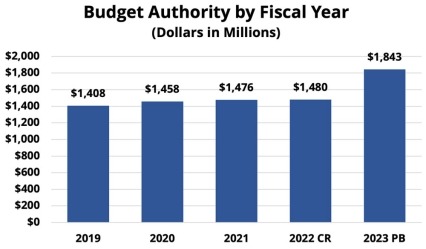The National Institute on Drugs and Addiction (NIDA) is the lead federal agency supporting scientific research on drug use and its consequences. Its mission is to advance science on drug use and addiction and apply that knowledge to improve individual and public health. After decades of research, addiction is now understood to be a chronic, treatable brain disorder from which one can recover. NIDA-supported research has led to the development of effective prevention and treatment interventions, providing hope for the millions of people in the United States diagnosed with substance use disorders (SUDs) and their loved ones.
The Addiction Public Health Crisis
- 20.4 million people in the United States were diagnosed with SUD in 20191
- In 2019, only 10.3 percent of people with SUD received SUD treatment1
- Nearly 92,000 people died of drug overdoses in 20202
NIDA’s FY Research Investment
- 389 Full-time equivalents (FTEs)
- 291 New research project grants
- 2231 Unique investigators in FY 2021
- 79 Early-stage investigators
- $269M for HEAL research
- $261M for HIV/AIDS research
- Basic Neuroscience: Understanding how drugs affect the cells and circuits of the brain, how addiction occurs, and how genes and environment affect the brain
- Epidemiology: Monitoring emerging trends in drug use
- Risk and Protective Factors: Identifying the factors that influence drug use, addiction, access to care, and related health outcomes
- Prevention: Developing and testing approaches to mitigate risk factors, promote resilience, and prevent drug use, addiction, and their consequences
- Treatment: Developing and testing medications, devices, and behavioral treatments for addiction and its consequences
- Implementation: Optimizing approaches for scaling up and enhancing access to evidence-based prevention and treatment strategies
Current Activities
- Mobile health solutions to rectify digital inequity. Supporting research to develop mobile health technologies specifically designed to ensure access by underserved and vulnerable patients affected by substance use disorder.
- NIH HEAL Initiative®. Administering over $250M/year on research to prevent and treat opioid misuse, addiction, and overdose, including studies to develop and test new interventions and effective strategies for implementing proven interventions across settings.
- Novel medications development. Funding innovative research to develop new medications for substance use disorder and overdose.
- Harm reduction. Supporting studies to prevent overdose deaths, reduce drug use, alleviate withdrawal symptoms, and reduce co-occurring infection.
- COVID-19 Impacts. Supporting research at the intersection of COVID-19 and substance use disorders to understand how the pandemic and related policy changes are impacting individuals and public health.
Recent Accomplishments
- Standard unit of THC for research. Established a standard unit of THC for research in collaboration with other NIH Institutes, which will allow comparison of cannabis intake and its effects across studies.
- HEALing Communities Study. Despite impacts of COVID-19, deployed a major communications intervention as part of this multisite implementation study across 67 diverse communities in four states.
- HEAL Prevention. Completed pilot research focused on preventing opioid use in adolescents; the studies are now transitioning to larger trials.
- Integra mobile van trial. Launched research to test using mobile health units to deliver integrated health services for people with opioid use disorder for HIV and substance use treatment and prevention.
- Clinical Trials Network. Published research showing that high dose buprenorphine induction in emergency departments is safe and well-tolerated in patients with untreated opioid use disorder.
Future Initiatives
- Fentanyl research. Funding research to address the urgent need to understand biological mechanisms, clinical manifestations, and best treatment practices for fentanyl addiction and overdose.
- Integrative Management of chronic Pain and OUD for Whole Recovery (IMPOWR) Network. Establishing a new research network to address co-occurring chronic pain and opioid use disorder by developing effective interventions and sustainable implementation strategies with an emphasis on diverse, vulnerable populations.
- HEALthy Brain and Child Development Study Phase 2. Starting recruitment of pregnant women for the most comprehensive study of early brain development ever conducted, which will follow women and their children from before birth through early childhood to determine how maternal drug exposure and other factors influence development.
- HEAL Prevention and Treatment Research. The HEALing Communities Study, Prevention Studies, and Justice Community Opioid Innovation Network will test strategies to expand effective prevention options, treatments, and care for people with opioid use disorder in community and justice settings.
- Clinical Trials Network. The CTN will conduct studies of behavioral, pharmacological, and integrated treatment interventions to determine effectiveness across a broad range of settings and populations with a new focus on areas of the country heavily impacted by the opioid crisis through HEAL Initiative funding.
References
- 2019 National Survey on Drug Use and Health
- 2020 The Centers for Disease Control and Prevention WONDER database


